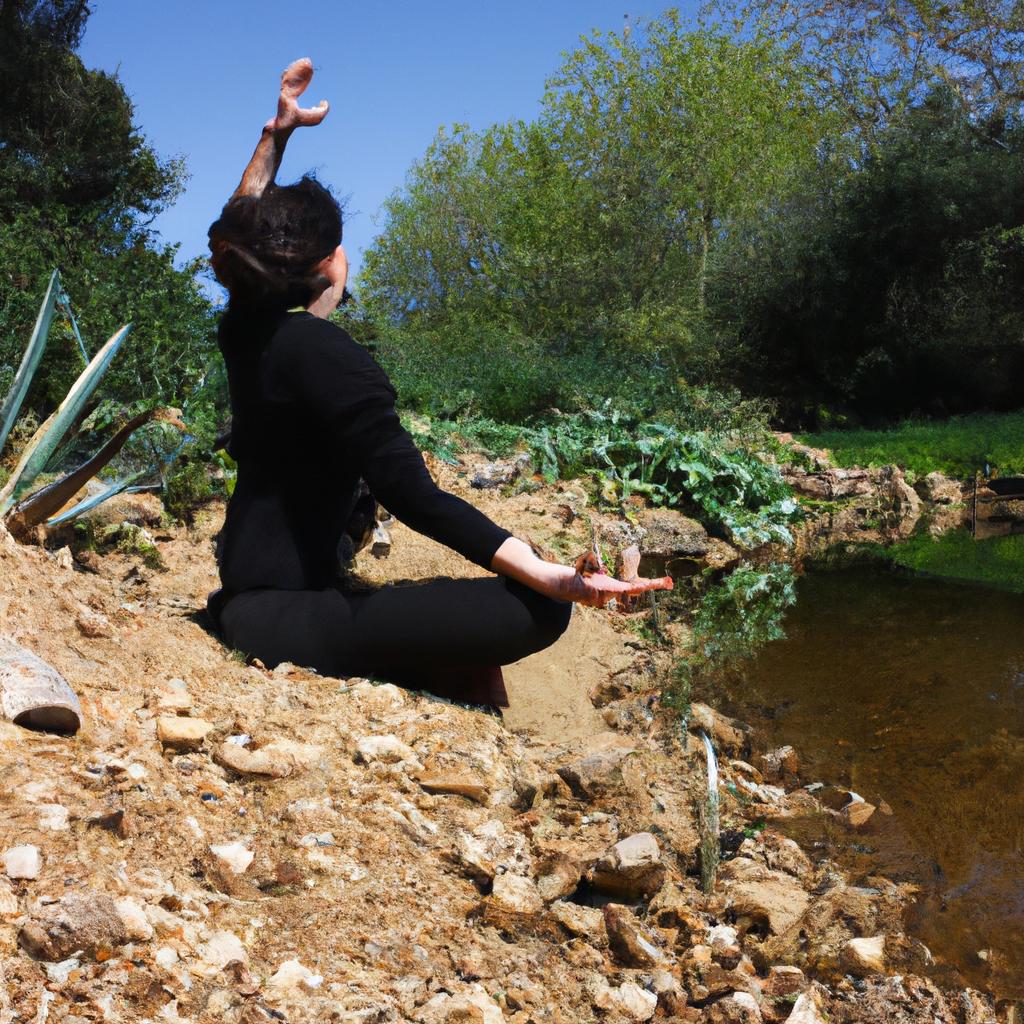Prayer, as a fundamental aspect of religious and spiritual practices, holds immense significance in various cultures worldwide. It serves as a means of communication with the divine or higher powers, providing individuals with solace, guidance, and a sense of connectedness. Understanding the different types of prayer is essential to comprehend the diverse ways in which people express their faith and explore their spirituality. For instance, consider an individual who finds comfort in reciting formal prayers within the confines of a religious institution. On the other hand, another person may find solace through silent meditation or reflection on nature’s beauty. These varied forms reflect the multifaceted nature of prayer and its ability to cater to unique spiritual needs.
Exploring the essence of prayer unveils its significance not only among followers of organized religions but also for those who identify as spiritual but non-religious (SBNR). While traditional prayers often involve spoken words or specific rituals conducted within established religious structures, SBNRs may approach prayer from a more personal perspective. They might engage in contemplative practices that emphasize mindfulness and self-reflection rather than adhering to prescribed texts or rites. Consequently, studying these distinct types of prayer highlights how individuals seek connection with the sacred in both communal settings and intimate moments of introspection , fostering a sense of inner peace and spiritual growth.
In addition to the variations in the ways people pray, prayer can also serve different purposes. Some individuals may use prayer as a form of supplication or petition, seeking guidance, strength, or intervention from a higher power. Others may engage in prayers of gratitude, expressing appreciation for blessings received or acknowledging the beauty and wonders of life. Prayer can also be a way to seek forgiveness or offer forgiveness to others, promoting healing and reconciliation.
Furthermore, prayer is not limited to specific religions or belief systems. It is a universal practice that transcends cultural boundaries and has been present throughout human history. Whether it takes the form of formal rituals within established religious traditions or personal moments of reflection and connection with the divine, prayer serves as a powerful tool for individuals to nurture their spirituality and find meaning in their lives.
Ultimately, understanding the diverse types and significance of prayer allows us to appreciate its role in shaping individual beliefs and fostering a sense of connection with something greater than ourselves. Regardless of one’s religious affiliation or spiritual inclinations, prayer remains an integral aspect of human experience that provides solace, guidance, and a means for self-discovery.
Types of Meditation
Imagine a busy city filled with people rushing through their daily lives, consumed by stress and anxieties. In the midst of this chaos, there is one individual who stands out – calmly sitting on a park bench, eyes closed, deep in meditation. This scenario illustrates the power of meditation as a transformative practice that can bring peace and tranquility to our hectic lives.
Meditation encompasses various techniques that aim to cultivate mindfulness and focus the mind. While each form differs in its approach, they all share a common goal: to quiet the incessant chatter of thoughts and find inner stillness. Let us explore some prominent types of meditation:
- Mindfulness meditation: This technique involves observing one’s thoughts without judgment or attachment. It allows individuals to be fully present in the moment, acknowledging sensations, emotions, and experiences as they arise.
- Loving-kindness meditation: Also known as metta meditation, it cultivates feelings of compassion towards oneself and others. Practitioners repeat loving phrases such as “May I be happy” or “May you be at ease,” extending these sentiments universally.
- Transcendental meditation (TM): TM utilizes mantras – specific words or sounds repeated silently – to help practitioners achieve a state of deep relaxation and heightened awareness.
- Guided visualization: In this type of meditation, individuals mentally create vivid imagery guided by an instructor or audio recording. Visualization aims to enhance focus, creativity, and positive thinking.
Engaging deeply in any form of meditation has numerous benefits for both mental and physical well-being. Consider the following emotional responses evoked from practicing:
- Reduced anxiety levels
- Increased self-awareness
- Enhanced empathy towards others
- Improved concentration
To further illustrate the impact of different meditative practices, let us examine a comparison table showcasing key aspects:
| Type | Key Focus | Benefits |
|---|---|---|
| Mindfulness | Present moment awareness | Stress reduction, improved focus |
| Loving-kindness | Cultivating compassion | Increased empathy, self-acceptance |
| Transcendental | Mantra repetition | Deep relaxation, heightened consciousness |
| Guided visualization | Imagery creation | Enhanced creativity, positive mindset |
As we can see from this comparison, each type of meditation offers unique advantages. By incorporating these practices into our lives, we have the potential to experience profound personal growth and transformation.
Transitioning seamlessly into the subsequent section on “The Power of Mantras,” we delve deeper into how specific words or sounds hold tremendous influence in our meditative journeys. Understanding their significance allows us to harness their power effectively and unlock further dimensions of inner exploration.
The Power of Mantras
Types of Prayer: The Essence in Religion and Spirituality
In the previous section, we explored the various types of meditation that individuals practice to promote mindfulness and inner peace. Now, let us delve into another significant aspect of religious and spiritual practices – prayer. To illustrate its importance, consider the following example:
Imagine a person facing a challenging situation in their life: financial struggles, relationship difficulties, or health issues. Feeling overwhelmed by these burdens, they turn to prayer as a means of seeking solace and guidance from a higher power. Through heartfelt prayers, this individual finds comfort in expressing their deepest concerns and hopes for resolution.
Prayer is an integral part of many religious traditions and spiritual paths across cultures. It serves as a channel through which individuals communicate with the divine or tap into their inner wisdom. While there are countless variations of prayer practices worldwide, they can generally be categorized into four main types:
- Supplication: This form involves asking for specific needs or desires from a higher power.
- Thanksgiving: Expressing gratitude towards the divine for blessings received.
- Intercession: Praying on behalf of others who may be experiencing hardship or illness.
- Contemplation: Engaging in silent reflection and communion with one’s inner self.
To further understand the diversity within prayer practices, let us examine a comparison table showcasing examples from different religions:
| Religion | Type | Example |
|---|---|---|
| Christianity | Supplication | Asking God for healing |
| Islam | Thanksgiving | Offering thanks after completing Ramadan |
| Buddhism | Intercession | Praying for world peace |
| Hinduism | Contemplation | Meditating on the essence of divinity |
These examples demonstrate how prayer manifests uniquely within each faith tradition while still fulfilling similar purposes such as seeking guidance, expressing gratitude, supporting others’ well-being, and fostering inner reflection.
In summary, prayer plays an essential role in religion and spirituality. It serves as a means of connecting with the divine or exploring one’s own inner landscape. Through supplication, thanksgiving, intercession, and contemplation, individuals find solace, express gratitude, support others, and engage in self-reflection. Now let us explore another fundamental aspect – mindfulness practices – that complement these spiritual endeavors.
With an understanding of the various forms of prayer established, we can now turn our attention to mindfulness practices and their significance in religious and spiritual contexts.
Mindfulness Practices
The Power of Mantras
Building upon the significance of prayer in our spiritual and religious practices, mantras hold a unique place in connecting individuals with their inner selves and transcending beyond the physical realm. Derived from ancient languages such as Sanskrit or Tibetan, mantras are sacred sounds, words, or phrases that are repeated either silently or aloud to evoke specific intentions or states of consciousness.
One example highlighting the power of mantras is the practice of chanting “Om” in Hinduism. This simple yet profound mantra represents the essence of universal sound and unity. Through regular repetition, individuals can experience a deep sense of peace, harmony, and connection to the divine within themselves. The transformative potential of this practice lies in its ability to quieten mental chatter and attune one’s focus towards higher spiritual planes.
To understand how mantras function as powerful tools for transformation, it is crucial to recognize some key characteristics:
- Vibration: Each mantra carries a distinct vibrational frequency that resonates with different aspects of our being.
- Intention: By repeating a mantra with conscious intention, we align ourselves with the desired qualities associated with that particular mantra.
- Repetition: Consistent repetition allows us to cultivate an intimate relationship with the mantra and deepen its impact on our psyche.
- Energy Flow: As we chant a mantra, energy flows through our vocal cords and permeates our entire being, creating a harmonizing effect.
In exploring various spiritual traditions across cultures, we find numerous examples where mantras have been utilized as vehicles for personal growth and self-realization. To further illustrate their diverse applications, consider the following table showcasing different types of mantras employed in various belief systems:
| Tradition | Mantra | Purpose |
|---|---|---|
| Buddhism | “Om Mani Padme Hum” | Cultivating compassion |
| Sikhism | “Waheguru” | Attaining spiritual enlightenment |
| Christianity | “Kyrie Eleison” | Seeking mercy and forgiveness |
| Islam | “La ilaha illallah” | Affirming the oneness of God |
As we delve into the significance of mantras, it becomes apparent that these sacred sounds have been integral to religious and spiritual practices throughout history. They serve as powerful tools for inner transformation, enabling individuals to access higher states of consciousness, align with their intentions, and cultivate a deeper connection with the divine.
Transitioning seamlessly into our next section about “Sacred Rituals,” we continue our exploration of how various practices facilitate our journey towards spirituality and self-discovery.
Sacred Rituals
Types of Prayer: The Essence in Religion and Spirituality
Transitioning from the previous section on mindfulness practices, it is crucial to explore the significance of sacred rituals within prayer. These rituals serve as a means for individuals to connect with their spirituality while engaging in religious traditions. To better understand this concept, let us consider the example of a devout follower attending a Sunday mass at their local church.
During the mass, several key elements contribute to the overall experience and act as signposts towards deeper connection and meaning. Firstly, communal participation creates a sense of unity among believers. As worshippers gather together, they share common beliefs and engage in collective prayers that foster a feeling of belongingness within the religious community.
Furthermore, structured liturgy plays an essential role in guiding participants through various stages of worship. From hymns sung in unison to scripted prayers recited by all, these pre-determined actions provide a framework for individuals to express their faith consistently. In this way, participants can tap into the rich history and tradition associated with each ritual, connecting not only with themselves but also with generations past.
- Sense of awe and reverence experienced during important ceremonies
- Feeling uplifted and inspired by beautiful music or art incorporated into worship
- Deep emotional connections formed when sharing personal stories or testimonials
- Profound joy felt when witnessing acts of kindness or charity within one’s religious community
Additionally, incorporating a table further supports our understanding:
| Sacred Rituals | Emotional Response |
|---|---|
| Ceremonial processions | Sense of wonderment |
| Lighting candles | Comfort and solace |
| Chanting or singing devotional songs | Spiritual elation |
| Partaking in sacraments | Cleansing and renewal |
In conclusion, sacred rituals hold immense importance within prayer practices across religions. Through communal participation and structured liturgy, individuals are able to connect with their spirituality on a deeper level. These rituals evoke various emotional responses, fostering a sense of belongingness and providing opportunities for personal growth within religious communities.
Transitioning seamlessly into the subsequent section on contemplative silence, we delve further into the exploration of prayer practices that enable introspection and self-reflection.
Contemplative Silence
Types of Prayer: The Essence in Religion and Spirituality
Sacred Rituals serve as a fundamental aspect of prayer across various religious traditions. They provide a structured framework through which individuals can express their devotion and connect with the divine. One illustrative example is the Hindu ritual of Aarti, where worshippers offer lighted lamps to deities while chanting hymns. This act symbolizes the offering of one’s own inner light to the divine, fostering a deep sense of connection and reverence.
- Lighting incense to purify the environment
- Bowing or kneeling as a sign of humility
- Chanting sacred mantras for focus and concentration
- Offering flowers or food as symbols of gratitude
These actions carry profound meaning within their respective religious contexts, evoking emotions such as awe, reverence, and surrender. By actively participating in these rituals, individuals deepen their spirituality and cultivate a stronger bond with their faith.
In addition to physical acts, contemplative silence plays an integral role in prayer practices. This form of prayer involves stillness and introspection, allowing individuals to quiet their minds and enter into a state of communion with the divine. Here is an example table showcasing different forms of contemplative silence:
| Type | Description | Benefits |
|---|---|---|
| Meditation | Focusing attention on breath or mantra | Enhances mindfulness |
| Centering Prayer | Repetition of sacred word or phrase | Cultivates inner peace |
| Mindfulness | Observing thoughts without judgment | Promotes self-awareness |
| Zen | Sitting quietly, detached from discursive mind | Encourages insight & clarity |
Engaging in contemplative silence enables individuals to deepen their spiritual connection, find inner peace, and gain insight into the nature of existence. By embracing these moments of stillness, practitioners can experience profound transformation and a sense of transcendence.
Transitioning into the subsequent section about “Devotional Acts,” it is crucial to recognize that prayer takes various forms across different religious traditions. These practices often involve acts of devotion aimed at expressing love, gratitude, and surrender to the divine. Understanding this diversity allows us to appreciate how prayer serves as a unifying force within religion and spirituality.
Devotional Acts
Contemplative Silence, as explored in the previous section, serves as a powerful form of prayer that allows individuals to connect with their inner selves and the divine. In this next section, we will delve into another significant aspect of prayer: Devotional Acts.
Devotional acts encompass various practices performed by individuals seeking spiritual connection or expressing their devotion to a higher power. These acts can vary across different religious traditions but share the common goal of deepening one’s relationship with the divine. To illustrate this, let us consider an example from Hinduism.
Imagine a devotee sitting inside a beautifully adorned temple, surrounded by the scent of incense and the soft chants of fellow worshippers. With hands folded in reverence, they offer flowers to an intricately decorated idol representing their chosen deity. This act is not just a mere ritual; it carries profound significance for the worshipper who believes that through such devotions, they can forge a deeper bond with their beloved god.
To understand further how devotional acts manifest in different religions and evoke emotional responses in practitioners, let us explore some key examples:
- Lighting candles and saying prayers at a shrine: This simple yet meaningful act is prevalent among Christians who believe that lighting candles symbolizes bringing light into darkness and signifies hope amidst challenges.
- Prostration: Commonly practiced in Islam, prostration involves bowing down before Allah during daily prayers. This physical act of submission cultivates humility and surrender towards God.
- Chanting mantras: Found in both Buddhism and Hinduism, chanting mantras creates rhythmic vibrations believed to have transformative effects on the individual’s consciousness.
- Pilgrimage: Embarking on a pilgrimage holds great importance in many faiths such as Islam (Hajj), Christianity (Camino de Santiago), and Buddhism (Kora). The journey itself becomes an act of devotion that often evokes feelings of awe, reflection, and purification.
In addition to these examples, various other devotional acts exist across religions, each offering unique ways for individuals to express their spirituality and connect with the divine. To provide a comprehensive understanding of these practices, consider the following table:
| Religion | Devotional Act | Purpose |
|---|---|---|
| Christianity | Praying the Rosary | Meditative reflection on Jesus’ life and teachings |
| Judaism | Shabbat observance | Honoring God’s commandments and creating sacred time |
| Sikhism | Langar (community kitchen) | Equality and selfless service towards others |
Through engaging in such devotional acts, practitioners often experience a range of emotions that deepen their spiritual journey. These may include feelings of love, awe, gratitude, peace, or even transcendence.
In conclusion, devotional acts form an integral part of prayer practices worldwide. They serve as powerful tools for individuals seeking to foster a deeper connection with the divine by expressing their devotion through meaningful rituals and actions. By engaging in these acts, people find solace, inspiration, and a sense of purpose in their religious or spiritual journeys.
 The Digital Sanctuary
The Digital Sanctuary



